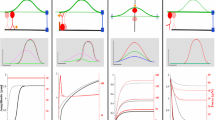Summary
Fiber cells isolated by mechanical disruption of the tissue in Ca2+-free sea water attach firmly to the substrate by discrete adhesion plaques. They are capable of forming a lamellipodium and long, slender extensions while the cell bodies remain stationary. The extensions are slowly elongated but can suddenly be withdrawn by contraction. Bundles of F-actin are attached with their “plus” ends close to the tips of the extensions. Within the cell body, microfilaments form a loose cortical layer and criss-crossing patches. Microtubules are not present in newly formed extensions but seem to stabilize “older” extensions. In these, they are bundled by crossbridges and oriented lengthwise. In the cell body, 37 nm “macrotubules” are found as well as the prevailing microtubules 24 nm in thickness. They radiate from an organizing center close to the mitochondrial complex, which can, however, also give rise to normal microtubules. Since this organizing center seems to nucleate either macrotubules or microtubules, but never both at the same time, it is speculated that it may exist in two alternative states.
Similar content being viewed by others
References
Abercombie M, Heaysman J, Pegrum SM (1971) The lomocation of fibroblasts in culture. Exp Cell Res 65:359–367
Behrendt G, Ruthmann A (1986) The cytoskeleton of the fiber cells of Trichoplax adhaerens (Placozoa). Zoomorphology 106:123–130
Burridge K, Molony L, Kelly T (1987) Adhesion plaques: Sites of transmembrane interaction between the extracellular matrix and the actin cytoskeleton. J Cell Sci [Suppl 8]:211–229
Dustin P (1984) Microtubules. Springer, Berlin Heidelberg New York
Eichenlaub-Ritter U, Tucker JB (1984) Microtubules with more than 13 protofilaments in the dividing nuclei of ciliates. Nature 307:60–62
Grell KG, Benwitz G (1971) Die Ultrastruktur von Trichoplax adhaerens F.E. Schulze. Cytobiologie 4:216–240
Grell KG, Benwitz G (1974) Spezifische Verbindungsstrukturen der Faserzellen von Trichoplax adhaerens F.E. Schulze. Z Naturforsch 29c:790
Klauser MD, Ruppert EE (1981) Non-flagellar motility in the phylum Placozoa: ultrastructural analysis of the terminal web of Trichoplax adhaerens. Am Soc Zoologists 21:1002
Oster GF, Perelson AS (1987) The physics of cell motility. J Cell Sci [Suppl 8]:35–54
Rassat J, Ruthmann A (1979) Trichoplax adhaerens F.E. Schulze (Placozoa) in the scanning electron microscope. Zoomorphology 93:53–72
Ruthmann A (1977) Cell differentiation, DNA content and chromosomes of Trichoplax adhaerens F.E. Schulze. Cytobiologie 15:58–64
Schliwa M (1986) The Cytoskeleton. Springer, Vienna New York
Schulze FE (1891) Über Trichoplax adhaerens. Physik Abh Kgl Akad Wiss Berlin, 1–23
Tilney LG, Porter KR (1967) Studies on the microtubules in Heliozoa: II. The effect of low temperature on these structures in formation and maintenance of the axopodia. J Cell Biol 34:327–343
Tilney LG, Kallenbach N (1979) Polymerization of actin: VI. The polarity of the actin filaments in the acrosomal process and how it might be determined. J Cell Biol 81:608–623
Travis JL, Bowser SS (1986) A new model of reticulopodial motility and shape: evidence for a microtubule based motor and an actin skeleton. Cell Motility and the Cytoskeleton 6:2–14
Verschueren H (1985) Interference reflection microscopy in cell biology: methodology and applications. J Cell Sci 75:279–301
Author information
Authors and Affiliations
Rights and permissions
About this article
Cite this article
Thiemann, M., Ruthmann, A. Microfilaments and microtubules in isolated fiber cells of Trichoplax adhaerens (Placozoa). Zoomorphology 109, 89–96 (1989). https://doi.org/10.1007/BF00312314
Received:
Issue Date:
DOI: https://doi.org/10.1007/BF00312314




